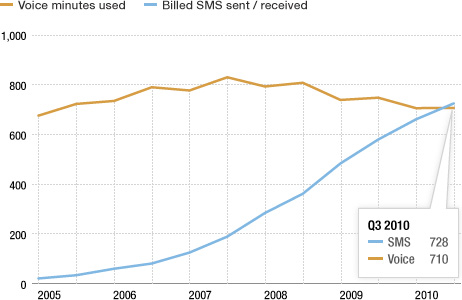
Millions of people use their smart phones to make calls. But voice quality remains just fair for most phones, according to Consumer Reports. Justin Sullivan/Getty Images.
March 10, 2011
By JOSHUA BROCKMAN
It seems as if there’s a new smart phone released every day. Each device promises a full menu of features that’s better than its competitors’ and the list keeps growing.
Surf the Web? Check. Listen to music? You bet. Send e-mail and texts? Absolutely.
And even though American consumers still talk a lot on their smart phones, there’s one fundamental function that’s consistently falling short — voice quality.
Across the board — from Motorola’s Droid X to the BlackBerry Torch — Consumer Reports gave most smart phones “fair” voice quality ratings in its latest reviews. The same trend is evident in reviews going back a few years. That’s in stark contrast to the “excellent” ratings given to display, Web browsing and even battery life features on smart phones.
“It seems that voice quality has been neglected. It’s adequate. Most of the phones we test — the voice quality hovers between good and poor,” says Mike Gikas, the senior electronics editor for Consumer Reports. “It’s probably the only area where cell phones aren’t making any headway in terms of improvements.”
It’s a conclusion supported by other studies, too.
“Shifts in wireless phone usage, including smart phone and texting use, as well as an increase in the percentage of wireless calls being made and received inside buildings, has led to a halt in overall call quality improvement,” according to a new wireless call study by J.D. Power and Associates.
Over the past two years, there has not been a “significant change in overall call quality performance across the industry,” following steady improvements between 2003 and 2009, the study says.
So, who’s to blame for the average voice and call quality — handset manufacturers or wireless carriers?
Limited Smart Phone Real Estate
“Cell phones are by far the most densely packed electronic devices out there,” Gikas says. That means there isn’t always room for a high-quality speaker and noise cancellation technology, he adds.
Gikas says manufacturers are focusing on the more profitable side of design by creating phones that are closer to mini computers that run apps and surf the Web.
“We know that voice quality is not driving sales of smart phones. When was the last time you saw an advertisement for a cell phone bragging about voice quality?” he asks. “It’s usually about the network or some capability other than voice quality.”
Reach Out And Text Someone
A few decades ago, voice quality was celebrated with some memorable commercials. Sprint touted a system that was “so incredibly quiet that you could actually hear a pin drop.”
And AT&T had its popular ad slogan: “Reach out and touch someone.”
These ads are from an era when corded phones were practically the only choice for calling a friend or relative. The only cord many consumers are used to having around these days is one for charging.
Given the state of voice calling on many smart phones today, a jingle with this tag line might be more appropriate: Reach out and text someone.
‘Voice Is An App’
As wireless carriers including AT&T and Verizon Wireless race to unroll their new 4G LTE networks, which promise faster data speeds, there’s also the potential for further voice enhancements. These networks will function using Internet Protocol (IP).
“What is important to realize it that on digital devices and digital networks voice is an app just like Angry Birds or CNN,” says Tom Wheeler, the managing director of Core Capital Partners, a technology-focused venture capital firm. “It is a software construct that just happens to do something that is similar to what a telephone used to do.”
The new IP networks that wireless carriers are building will change the landscape from what used to be an analog experience into a fully digital one. “We are currently living through the transition from the voice-centric network and device to the IP-centric network and device,” Wheeler says.
How Voice Factors Into Mobile Design
David Townsend, the chief designer for Samsung, recognizes that consumers are increasingly turning to video chat or Skype, a Voice over Internet Protocol (VoIp) service, to communicate. Still, he says, mobile phones remain a “leading medium” for phone calls.
“In fact, as more and more people drop their landlines in favor of mobile phone lines, the need for handset manufacturers and carriers to deliver a quality voice experience will be even more important,” Townsend says.
Both Samsung and Motorola — two giant smart phone manufacturers — say voice quality remains an R&D priority worthy of continued investment.

There’s been a “halt” in overall call quality improvement for mobile phones, according to a new study by J.D. Power and Associates. Adele Hampton/NPR.
Jim Wicks, Motorola Mobility’s director of consumer experience design, says mobile handsets need to have a quality speaker and components, software to optimize acoustics and adequate air space around the speaker in order to deliver good voice quality. But he says it’s not just about the handset — it’s also about the carrier.
Networks And ‘Un-Sexy’ Profits
“Voice quality is primarily a function of the networks, not the devices,” says Charles Golvin, principal analyst for Forrester Research. “That is, on each carrier’s network every phone, from the fanciest smart phone to the most basic feature phone, [uses] the same technology for transmitting and receiving voice calls.”
He says the algorithms for encoding and decoding voice for these networks have evolved to improve both voice quality and network efficiency. Ultimately, that helps improve the carrier’s profitability.
Golvin says voice is a “decidedly un-sexy” feature, though it still accounts for the majority of wireless companies’ profits.
Keep On Talking
Mark Siegel, a spokesman for AT&T, says the company is focused on improving “all aspects of call quality,” whether it’s clarity of sound, [or] dropped calls, which are especially frustrating to people.
Still, he says the company’s growth is being driven by wireless data revenue, which rose to $4.9 billion — an increase of $1.1 billion — in the fourth quarter of 2010, compared to the same period a year earlier.
Voice held its own, though, accounting for the lion’s share of AT&T’s $15.2 billion in revenue.
Tom Pica, a spokesman for Verizon Wireless, says recent voice quality studies demonstrate that it is “tops in call quality and/or above the industry average across the U.S.”
Verizon’s wireless data revenue grew to $5.3 billion in the fourth quarter of 2010, an increase of 26 percent from a year earlier. But voice still represented the majority of the company’s $16.1 billion in wireless revenue.
When it comes to mobile phones, Americans just keep on talking: On average, since 2005, U.S. mobile phone users talked for at least 11 hours each month, according to the Nielsen Co.
Where Talk Meets Text
U.S. mobile phone users have consistently talked a lot — at least 11 hours each month — since 2005.There’s little sign of this slowing down even though text messaging and data usage is on the rise.

Figures for voice minutes and SMS text messages are monthly.
Source: The Nielsen Co.
© NPR
